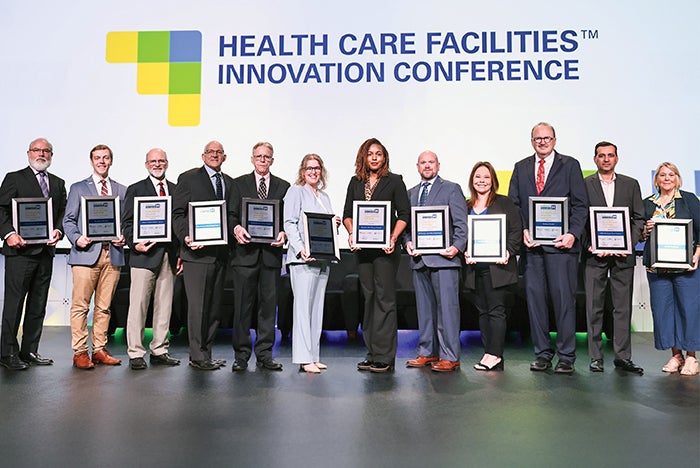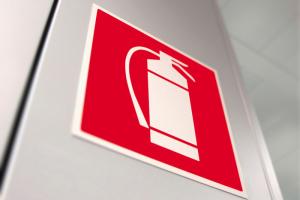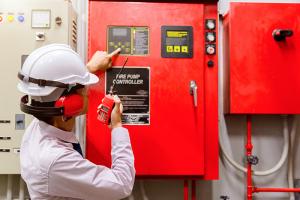2025 ASHE Sustainability Champions

Accepting their ASHE Sustainability Champions Awards at the Health Care Facilities Innovation Conference™ in July were (from left) representatives of Advocate Health (representing 27 winning facilities), Ascension Healthcare (representing 10 winning facilities), Children’s Hospital Colorado – Anschutz, Kaiser Permanente (representing 16 winning facilities), Memorial Hermann Health System (representing 15 winning facilities), Bon Secours Mercy Health (representing seven winning facilities), Methodist Olive Branch Hospital, OSF Saint James – John W. Albrecht Medical Center, Pali Momi Medical Center, Parkland Health, Prime Healthcare (representing six winning facilities) and UPMC Northwest.
Image courtesy of ASHE
The winners of the American Society for Health Care Engineering’s (ASHE’s) 2025 Energy to Care® Awards were honored for significantly reducing their energy use and emissions and advancing their sustainability goals.
This year, an unprecedented 87 facilities across 12 health care organizations earned the Sustainability Champions Award, the program’s highest distinction, for demonstrating strong leadership in pursuit of reducing health care’s environmental footprint and using saved resources to support patient care.
The 87 Sustainability Champions Award winners — which are profiled here either as organizations of multiple winners in the main story, or as single facilities in the sidebar below — represent less than 2% of the total facilities participating in ASHE’s Energy to Care Program, which allows organizations to track and reduce their energy usage.
To view the complete list of 2025 Energy to Care winners, including the names of all the Sustainability Champion facilities and Sustained Performance award-winning facilities, access the winner list online.
Advocate Health
Power moves by an energy management leader
With 27 of its health care facilities each claiming a Sustainability Champions Award this year, Advocate Health casts a large profile among this year’s award winners. In fact, one of the health care organization’s regions encompassing 7.5 million square feet of acute care space has reduced its energy consumption by 37% since 2012.
Advocate’s Energy Connect program provides specialized training for mechanics on heating, cooling and air-handling systems, helping recognize improvements that can dramatically decrease energy use. It also ensures systems are inspected at least annually for both operational integrity and energy performance.
Rolling out Energy Connect across diverse hospital cultures wasn’t easy. Although some conservation measures didn’t immediately meet projections, collaborative problem-solving and consistent on-site support helped facilities discover workable solutions. Beyond the energy savings has been a lasting culture shift: Facilities teams now view energy management as their own mission, actively driving improvements from within.
Last year, the organization also implemented an automated system that uploads utility invoices into a centralized dashboard. This handy resource breaks down data visually, highlighting trends in electricity and natural gas use, electrical demand, year-over-year changes and 12-month rolling energy use intensity numbers. Regular data reviews help keep energy management a visible, ongoing priority for facilities directors.
Michael Roberts, PE, CHFM, SrHE, SASHE, enterprise director of energy services in facilities management for Advocate Health, recommends benchmarking energy data in a dashboard (such as Energy to Care), where it can be reviewed, analyzed and tracked. “Set a goal, even if it is to not increase consumption, and work toward it. You will always find little things that add up to measurable energy reductions,” he says. “Remember, too, that driving energy reduction is a journey, and you must stay with it over the long haul. Don’t let blips or unusual increases in consumption deter you.”
Ascension Healthcare
Scaling sustainability across the system
Ascension boasts 10 award-winning facilities this year, each benefitting from measurable improvements via an array of systemwide initiatives and local innovation. Among the major milestones in fiscal year 2024 was the complete replacement of desflurane — an inhaled anesthetic with high emissions — with sevoflurane. “[This] resulted in measurable environmental sustainability improvements,” explains services provider Medxcel’s Andrew Fairbank, energy project manager. “The environmental impact of this change is equivalent to avoiding more than 10 million miles of driving annually.”
Several of its hospitals also rolled out targeted projects. Ascension NE Wisconsin’s Mercy and St. Elizabeth campuses enhanced building performance using retrocommissioning and automation system upgrades, helping them achieve Environmental Protection Agency ENERGY STAR® certifications in 2024 and 2025. Meanwhile, Ascension St. Vincent Warrick enhanced heating, ventilating and air-conditioning (HVAC) efficiency with variable-frequency drives and steam system upgrades. Further, Ascension St. Vincent’s Clay County enlarged its clinical plastics recycling program while supporting community garden initiatives.
Now used across all sites are efficient design standards like enhanced lighting controls, point-of-use electrification of heating utilities and construction waste diversion efforts. Ascension’s medical device reprocessing program diverted more than 169,000 pounds of waste from landfills and saved $20.6 million last year alone. Another impressive result of Ascension’s sustainability strategy is the ability to scale proven practices without compromising patient care, as demonstrated at the St. Elizabeth Campus, where placing building systems in “auto” mode improved efficiency while enhancing comfort in the environment of care.
These wins demonstrate how operational changes and incremental infrastructure upgrades can produce effective, scalable results. Supporting this work are strong facility partnerships, real-time data tracking and internal equipment-sharing platforms like Medxcel Marketplace, which helps reduce both waste and procurement costs. Together, these efforts are setting a new standard for environmental stewardship in health care.
“Successful sustainability programs are built on a foundation of culture, data and collaboration,” Fairbank continues. “Engaging facility teams through training and recognition ensures long-term commitment, while real-time data tracking enables targeted, high-impact interventions. Starting with small, proven initiatives can build momentum and demonstrate value, making it easier to scale efforts systemwide.”
Bon Secours Mercy Health
Smart savings, one system at a time
Bon Secours Mercy Health believes effective energy management begins with better awareness. Understanding each building’s systems, controls and operational patterns has positioned its seven award-winning hospitals to operate with greater efficiency.
Recognizing that health care requires balancing innovation with fiscal responsibility, the organization places importance on strategic minimal-expense efficiency practices. Some of its campuses have trimmed yearly utility costs by 5% to 10% through simple adjustments to system settings and optimized runtimes.
Additionally, smart operational procedures are standard across the system. For example, HVAC and lighting schedules are routinely aligned to real-time occupancy, new equipment installations emphasize high-efficiency models that dynamically adjust to demand, and a shift from pneumatic to direct-digital controls has unlocked advanced sequencing strategies.
“What’s more, we’ve seen a cultural shift at our locations. Facilities leaders now are actively comparing data, sharing best practices and championing low- and no-cost efficiency measures that have significantly reduced both energy use and emissions,” notes Ann Walston, vice president of acute care facilities management at Bon Secours Mercy Health.
Foundational maintenance persists as another key focus. In its everyday practices, the organization continues to marry innovation with operational discipline, consistently achieving measurable results. Routine procedures like steam trap surveys prevent waste and enhance system performance. Its hospitals also have successfully leveraged utility analytics and real-time usage reviews to quickly identify anomalies and savings opportunities, producing significant operational improvements.
“What’s particularly impressive is how many of our award-winning sites are working with legacy systems,” Walston adds. “These aren’t always brand-new buildings with cutting-edge infrastructure; they’re often older facilities with aging equipment. Yet our teams have found ways to extend the lives and performance of these systems.”
To ensure a more enduring impact, lessons learned from these methods are embedded into organizationwide design protocols, which means future projects can be more efficient from the start. Walston credits sustained leadership engagement, data-driven decision-making and a culture of shared accountability with its success.
Kaiser Permanente
Turning efficiency into a team effort
Kaiser Permanente earned the second-highest number of awards in 2025, courtesy of its 16 exceptional hospitals honored. The system has taken a comprehensive, organizationwide approach to energy efficiency by combining innovation, operational best practices and data-driven management.
Its combined efforts have helped avoid nearly $40 million in energy costs over the past 12 years. In the past year alone, Kaiser Permanente saved an estimated $1 million by expanding nighttime setbacks and more than $700,000 through its automated fault detection and diagnostics tool, Clockworks. Although integrating new technologies has come with its share of challenges, sustained leadership engagement and consistent communication have generated significant and lasting progress across its many facilities.
“Improving the health of the communities we serve is core to our mission,” says David Lockhart, CHFM, CEM, CRL, FASHE, Kaiser Permanente’s national executive director of facilities operations.
“A dedicated national sustainability team steers monthly leadership meetings to review performance and identify new opportunities for savings across the enterprise,” he says. “Teams emphasize sharing best practices and uncovering site-specific improvements. Supporting these efforts is a robust data and analytics team that provides monthly performance reports, enabling sites to track progress and benchmark results.
“Another strength of the program has been the adaptation of best practice tools like the utility optimization playbook, which offers facilities teams simple, actionable steps to better understand their energy operations, along with proven conservation practices, and, more recently, the Energy and Water Operating Guidelines,” Lockhart adds.
The organization also has successfully debuted utility retrocommissioning projects and energy treasure hunts to disclose more opportunities for hidden savings. And partnerships with utility providers further enhance performance through incentive programs and support services.
Lockhart’s advice to other health care facilities? “Get executive leadership support, and don’t be afraid to involve staff from other departments,” he says. “Set and track annual sustainability goals and talk about energy performance in all department meetings to keep everyone involved.
“What’s most satisfying about being named a Sustainability Champion is living our important mission and recognizing all the teams and leaders who have worked hard to make a difference,” Lockhart adds. “In addition to maintaining and serving our facilities, members and staff, they get to share in this meaningful recognition.”
Memorial Hermann Health System
Cutting costs, emissions and BTUs
With 15 award-winning facilities this year, Memorial Hermann Health System has clearly prioritized fundamental, high-impact energy management practices.
In 2024, the organization concentrated on optimizing HVAC performance through three core strategies: unoccupied scheduling with airflow and temperature adjustments, static pressure reset on air handlers to reduce motor loads and discharge temperature resets combined with free cooling based on outdoor conditions. Its hospitals also completed more LED lighting retrofits, high-efficiency boiler upgrades, central plant optimizations, night setbacks for operating room HVAC systems and natural gas to electric reheat transitions. To date, Memorial Hermann locations have decreased emissions per square foot by up to 30% and achieved more than $190 million in cumulative cost savings, with individual facilities reporting 40% to 60% reductions in British thermal unit usage and operational expenses versus baseline levels.
The organization put an increased focus on HVAC systems, which commonly represent more than half of a hospital’s energy use. Katy Hospital decreased energy use by 59%, while The Woodlands Hospital slashed consumption by 40%.
Consequently, Memorial Hermann is the beneficiary of 10 Sustainability Champions Awards for its hospitals and five for its medical office buildings. Notably, Cypress Hospital achieved a top ENERGY STAR score of 100, and Katy and Sugar Land hospitals racked up scores of 99.
Amazingly, hospitals in the system have secured 146 ENERGY STAR certifications over the past 15 years. Memorial Hermann also has been honored with the ENERGY STAR Partner of the Year for Sustained Excellence for 10 consecutive years, reaffirming its leadership in responsible energy oversight.
“Recognition and appreciation for a job well done go a long way in keeping people motivated,” says Larry Newlands, CEM, CEP, director of energy management at Memorial Hermann Health System. He adds that the most challenging aspect involved with these sustainability initiatives was the human factor — “convincing people that we could make a difference just by the way we operate a facility, getting everyone’s input and then sharing the results on a regular basis.”
Prime Healthcare
Prime time for smart energy moves
Prime Healthcare, which represents six winning facilities, has standardized automation systems, upgraded its hospitals to new operational standards and expanded its existing utility tracking system into an enterprisewide platform — enhancing visibility and enabling proactive responses to potential system failures. Helping matters is the partnership it formed with Ecom-Energy Inc., which enables Prime to drive energy and sustainability management on a large scale and conduct a multi-state portfolio evaluation to identify energy-saving prospects — from low-cost projects like lighting upgrades to high-capital investments such as direct-digital controls, HVAC improvements and on-site generation.
Between 2024 and 2026, Prime is spotlighting a three-pronged plan — energy-efficiency upgrades, controls and automation enhancements, and the integration of renewables and on-site power generation. Several of its hospitals have already completed lighting retrofits, water conservation improvements and operational system sequencing adjustments, achieving an extra 12% savings through upgraded energy management systems. Additionally, Prime’s on-site generation portfolio includes fuel cells at five of its awarded facilities and solar implementation at Desert Valley Hospital, ensuring more reliable and cleaner electricity and diminishing emissions. Given the system’s size and regional variability, tailoring solutions to each facility is essential.
“Prime was one of the first health care organizations to install a solid oxide fuel cell and is now looking at newer technologies such as linear generators and microgrids,” says Rakesh Seth, CHFM, CHC, Prime Healthcare’s vice president of facilities and construction. “While Prime’s energy partner has been tracking Scope 2 emissions for almost 10 years, we have now expanded emissions tracking to include Scopes 1 and 3 for our California and New Jersey facilities — two of the largest regions in our portfolio.”
Despite rapid expansion, Prime has maintained momentum in energy and sustainability, successfully advancing portfoliowide initiatives while growing operations. It’s a testament to its long-term commitment to environmental stewardship and operational excellence.
Ultimately, it doesn’t take big initiatives to make an impact, Seth insists.
“Start small and work your way up,” he advises. “Always take the long-term view to energy and sustainability management. And find an energy partner you can trust.”
More Sustainability Champions Award-winning facilities
In addition to the health care organizations covered in the main article that saw many of their individual facilities win the American Society for Health Care Engineering’s Sustainability Champions Award, several hospitals not part of these organizations also received the Sustainability Champions Award, including:
- Children’s Hospital Colorado – Anschutz in Aurora. This hospital’s stellar numbers helped it earn a sustainability prize this year — including maintaining an Environmental Protection Agency ENERGY STAR® score of 85, reducing nitrous oxide use, decreasing emissions, saving 7.4 million kilowatt-hours (kWh) ($1.24 million) annually after LED fixture retrofitting and conserving 60,000 kWh per year thanks to a new chiller and heat exchanger. “Having dedicated staff to monitor and manage your building’s energy consumption is a must,” says John M. Hudgens, the hospital’s sustainability manager.
- Methodist Olive Branch (Miss.) Hospital (MOBH). The first LEED for Healthcare Gold-certified inpatient facility in the United States, MOBH has consistently maintained an ENERGY STAR rating of 94 or higher, achieving 1% to 6% annual energy savings more than originally planned. Designed for 35% lower energy costs than a baseline hospital, it features ground source heat pumps, dynamic photoelectric glass, dedicated outdoor air systems, occupancy sensors and LED retrofits, continually improving efficiency to better serve patients and the community. MOBH facility services director Eric Poulos recommends that hospitals “look at what you have in place and always ask how you can make it more efficient. Think about next steps to make your building cost less annually to operate.”
- OSF Saint James — John W. Albrecht Medical Center in Pontiac, Ill. In 2024, this hospital completed significant energy-efficiency upgrades as part of a strategic, comprehensive energy and sustainability program that was designed and guided by Pointcore in Peoria, Ill. Its facilities management energy and sustainability team spearheaded initiatives, including a condenser water optimization, steam trap survey and repairs, and kitchen hood controls. These projects are projected to decrease annual energy costs by $26,000 and reduce energy consumption by 150,000 kWh and 23,700 therms. “Creating a clear connection between sustainability and mission is crucial to driving your program forward and engaging employees throughout all levels of the organization,” says Michael Keefe, Pointcore’s energy and sustainability manager.
- Pali Momi Medical Center (PMMC) in Aiea, Hawaii. In 2024, PMMC’s ENERGY STAR score rose to 99, up from 96 in 2023. Sustainability upgrades made over a decade include new fan-wall air-handling units, LED lighting retrofits and a 70% reduction in synthetic natural gas use through staged boiler controls. Rooftop solar panels are scheduled for next year, alongside ongoing system upgrades and operational efficiencies like chiller and temperature setbacks. “We continue to make changes to increase efficiency during day-to-day operations,” explains Jessica Onaga, CHFM, CHC, CHSP, PMMC’s facilities director. “The key is to rely on your teams. Everyone can contribute to finding ways to reduce energy use.”
- Parkland Health in Dallas. This hospital features six LEED Gold buildings and holds an ENERGY STAR score of 88, making it the largest ENERGY STAR-certified health care campus in the country. Parkland’s Dallas campus cut electricity and natural gas use by 3% — saving 3.94% in costs — diverted 7,790 tons of waste and sourced 25% of its energy from renewables while optimizing boilers, chillers and temperature setpoints. “I recommend that organizations start with their HVAC and building automation systems,” says Marcus Phipps, the hospital’s utility engineer. “Minor tweaks can come with big savings and a positive impact on the environment.”
- University of Pittsburgh Medical Center (UPMC) – UPMC Northwest in Seneca, Pa. Since launching its energy program in 2017, UPMC Northwest reduced electricity use by 19%, gas use by 11% and emissions by 21% compared to 2018. Upgrades included digital controls, LED lighting and chiller plant optimization. The program delivers $230,000 in annual savings, a payback under four years, and raised the hospital’s ENERGY STAR score from 59 to 83, earning certification in 2022. “This holistic approach to energy management not only improved operations but also reduced the facility’s annual emissions by 770 metric tons,” says Kate Zettl, director of energy/environmental engineering for UPMC’s Center for Sustainability.




